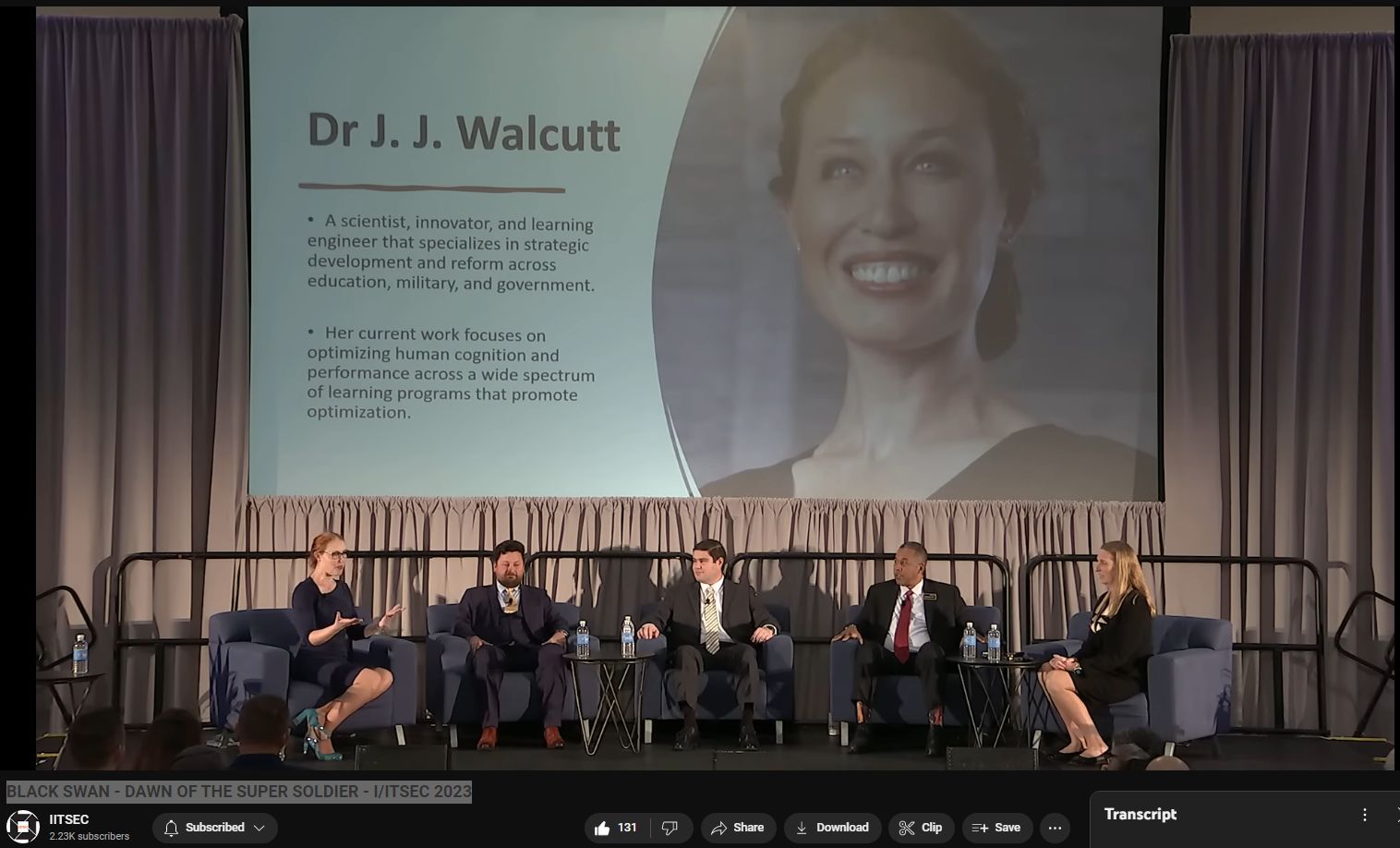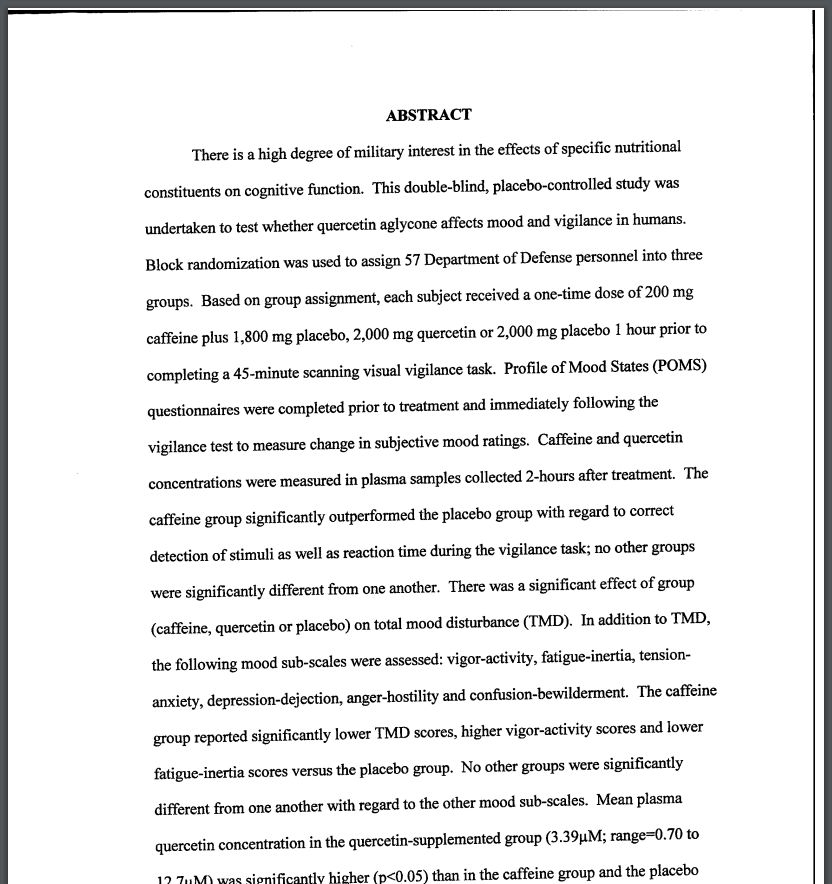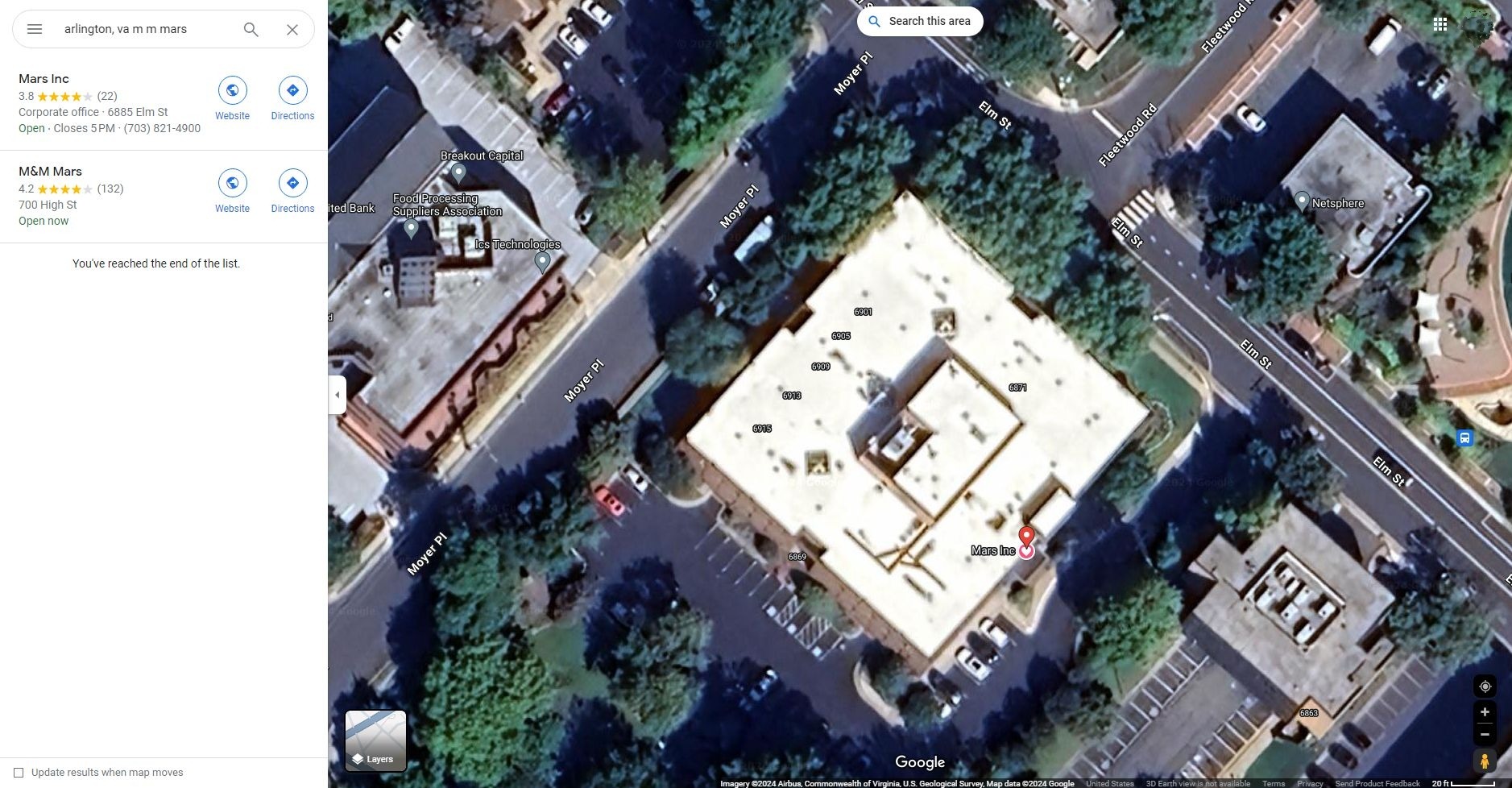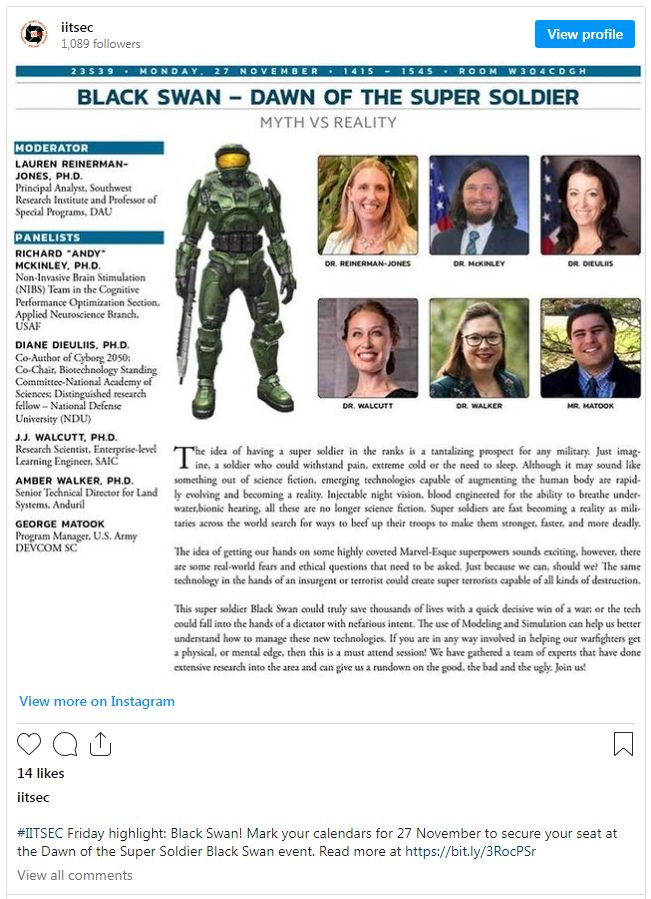Super-Soldier research involving Flavonoids and beyond
M&M Mars, Inc — headquarters of the candy company — 6885 Elm St, McLean, VA — Building has few, thin windows; no markings at all; nothing signifying M&M Mars Inc corporate anything. Seems instead secretive, opposite of promotional, fun, candy, goodies. Insider reports that the second floor is open-floorspace with no walls; single podium with a meat-cleaver; lighting is via 3 pyramidal skylights. Satellite confirms 3 pyramidal skylights.
https://www.marscocoascience.com/scientific-research/20-years-research
“A strong body of evidence shows these compounds can have profound impacts on human health. “
Army is a hammer, but super-soldiers are a scalpel.

~18:00 in — What is a super-soldier?
~50:00 in — RE heartlessness
~55:00 in — 90% of published super-soldier studies coming out of China
~1:04:00 — 3 major issues in 18-22yo age range: overweight, undereducated, self-regulation problems — eligibility dropped from 29% in ~2018, down to 22% in 2023.
“Super soldier” programs often explore enhancing human performance beyond natural limits through technological, genetic, and pharmacological methods. These initiatives, potentially pursued by military organizations like DARPA, might include developing advanced exoskeletons, integrating humans with machines (cybernetic enhancements), and researching substances like flavonoids for cognitive and physical enhancement. The goal is to create soldiers with superior strength, endurance, and cognitive abilities, capable of performing in extreme conditions that would be challenging or impossible for regular humans.
Super-Soldier Programs: DARPA, SAIC, and the DoD’s Quest for Enhanced Warriors
In the realm of defense and national security, the concept of the “super soldier” is not confined to the pages of comic books or the screens of Hollywood. Institutions like the Defense Advanced Research Projects Agency (DARPA), Science Applications International Corporation (SAIC), the Pentagon, and the Department of Defense (DoD) are at the forefront of research and development efforts to enhance the capabilities of soldiers beyond natural human limits.
DARPA’s Pioneering Role
DARPA, known for its role in developing emerging technologies for the military, has been instrumental in pioneering super-soldier programs. These initiatives focus on augmenting human performance through a blend of technological, biological, and physical enhancements. Projects under DARPA’s umbrella have explored exoskeletons that grant extraordinary strength and endurance, neural implants to enhance cognitive abilities, and biochemical tools that can alter the human body to better withstand the rigors of combat.
SAIC’s Contributions
Science Applications International Corporation (SAIC), a defense contractor, collaborates closely with the U.S. military in these endeavors. SAIC has been involved in developing advanced technologies, including robotics and artificial intelligence, to support the super-soldier programs. Their research aims to integrate humans and machines, creating a new breed of warfighter equipped with enhanced physical and cognitive capabilities.
Pentagon’s Vision and Initiatives
The Pentagon, as the headquarters of the United States Department of Defense, oversees these ambitious projects, ensuring they align with national security objectives. It envisions soldiers who can operate in environments that would be inhospitable or lethal to ordinary humans. This vision includes soldiers with enhanced mental acuity to process information rapidly and make decisions in high-stress situations, as well as physical abilities that far surpass those of a normal human being.
DoD’s Strategic Investments
The Department of Defense, through its various branches and research arms, invests strategically in technologies and sciences that contribute to the super-soldier concept. This includes funding research in biotechnology, materials science, and advanced computing. The DoD’s investments aim to translate these scientific discoveries into tangible military advantages, ensuring that the super-soldier programs are not mere science fiction but a realistic component of future military operations.
Ethical and Technological Challenges
These programs, while promising, are not without controversy. Ethical questions arise regarding the extent to which human beings can be enhanced or altered for military purposes. Technological challenges also abound, as the integration of advanced technologies with the human body presents unprecedented scientific hurdles. The potential for such enhanced individuals to change the nature of warfare and international security is profound.
Future Prospects
As research continues, the line between soldier and machine becomes increasingly blurred. The future super soldier might be a hybrid entity, combining the best of human intuition and adaptability with machine precision and durability. However, this future raises important questions about the essence of humanity, the ethics of enhanced warfare, and the potential for new types of global conflict.
Conclusion
The pursuit of super-soldier capabilities by DARPA, SAIC, the Pentagon, and the DoD represents a significant shift in the paradigm of military strategy and human enhancement. While the possibilities are groundbreaking, they necessitate a careful examination of the ethical, technological, and strategic implications. As these programs advance, they will undoubtedly continue to spark debate, inspire innovation, and potentially redefine the future of combat and the soldier’s role within it.
| Entry | Ordinal | Reduction | Reverse | Reverse Reduction |
|---|---|---|---|---|
| augmentation | 140 | 50 | 184 | 67 |
| boost | 71 | 17 | 64 | 28 |
| candy | 47 | 20 | 88 | 25 |
| candybar | 68 | 32 | 148 | 49 |
| chocolate | 82 | 37 | 161 | 44 |
| dod | 23 | 14 | 58 | 13 |
| elmst | 69 | 15 | 66 | 30 |
| enhancement | 102 | 48 | 195 | 51 |
| flavonoid | 98 | 44 | 145 | 46 |
| food | 40 | 22 | 68 | 14 |
| gmo | 35 | 17 | 46 | 10 |
| killing | 74 | 38 | 115 | 43 |
| mars inc | 77 | 32 | 112 | 49 |
| military | 107 | 44 | 109 | 55 |
| mkultra | 96 | 24 | 93 | 48 |
| murder | 79 | 34 | 83 | 38 |
| oxidation | 111 | 48 | 132 | 51 |
| pentagon | 92 | 38 | 124 | 34 |
| soldier | 82 | 37 | 107 | 44 |
| supersoldier | 161 | 62 | 163 | 73 |
| treat | 64 | 19 | 71 | 35 |
| usarmy | 97 | 25 | 65 | 38 |
| war | 42 | 15 | 39 | 21 |
| warfighter | 115 | 61 | 155 | 56 |
===
Quercetin & Caffeine supplement

PDF – quercetin supplement ADA405046
===
Patents assigned to Mars, Inc.
https://patents.justia.com/assignee/mars-incorporated
There are over 1,500 patents and/or applications; below are subjectively more interesting —
PROCESS AND APPARATUS FOR THE PRODUCTION OF A MEAT ANALOGUE
Abstract: Processes for the production of a meat analogue, comprising: a) introducing a meat batter which comprises protein into a first heating unit and heating the meat batter to a temperature above the denaturation temperature of the protein in the meat batter, but below the melting point of the protein to produce a first heat-treated product, and b) transferring the first heat-treated product to a second heating unit and heating the first heat-treated product to a temperature above the melting temperature of the protein to produce a second heat-treated product, c) cooling the second heat-treated product by moving through a cooling unit, so that the second heat-treated product has a temperature below water boiling temperature at ambient pressure when exiting the cooling unit, and d) dividing the cooled second heat-treated product into pieces; as well as an apparatus for the production of a meat analogue.
Orange and red anthocyanin-containing colorants
Abstract: The present application is directed to a method of hard pan coating an edible core, a sucrose-based, hard panned coating, and a hard panned confection comprising an edible core coated with the same. The sucrose-based, hard panned coating comprises sucrose and a pH-adjusted red radish anthocyanin-containing colorant, is substantially crystalline, and has a red or orange hue described by a CIELCH color space h° coordinate of from about 15° to about 70°. In some embodiments, the coating further comprises a yellow colorant. The colorants are desirably naturally sourced to provide alternatives to synthetic colorants for coloring hard panned confectionery coatings in red or orange hues.
Hybrid plant products from species and methods of making the same
Abstract: Methods for hybridizing members of the Theobroma genus, and particularly to methods for hybridizing Theobroma cacao and Theobroma grandiflorum are provided. Hybrid seeds, plants and plant parts thereof, obtained from these methods are also provided. Methods for confirming that the resulting progeny are hybrids are described. Theobroma hybrid plant products, such as seeds obtained by crossing Theobroma cacao and Theobroma grandiflorum, having modified chemical compositions, such as modified fatty acid content, and/or modified alkaloid content, are provided. Products obtainable from the hybrid plants and seeds, particularly foodstuffs such as cocoa products, are also provided.
Methods for increasing palatability of pet foodstuff
Methods for producing foamed meat or fish products and products produced thereby
Abstract: Foamed meat or fish products and methods of producing the same are provided. The methods comprise feeding a raw material comprising comminuted meat or fish and connective tissue to a dispersing apparatus. A gas is also provided to the dispersing apparatus and the dispersing apparatus operated to provide the foamed meat or fish product. The foamed meat or fish products so produced include gas bubbles having an average size of 0.1 to 7 mm.
Methods and compositions for improving cognitive function
Abstract: This invention relates to compositions, and methods of use thereof, for (i) enhancing executive cognitive function(s) (for example, decision making, planning, working memory, multitasking, judgment, numerical problem-solving, reading comprehension), and/or (ii) increasing blood flow in brain vasculature, comprising administering to a subject in need thereof, certain polyphenols such as flavanols, procyanidins, or pharmaceutically acceptable salts or derivatives thereof.
METHODS OF DIAGNOSING AND TREATING CHRONIC KIDNEY DISEASE
Abstract: The presently disclosed subject matter relates to methods of diagnosing and treating chronic kidney disease (CKD) in an animal, comprising determining the amount of magnesium in a sample of the animal and providing the animal with a treatment regimen. In certain embodiments, the treatment regimen comprises administering an effective amount of magnesium.
METHODS FOR PRODUCING FEATHER-BASED FOOD PRODUCTS
Abstract: A method is provided for making food product ingredients from indigestible keratinous protein-containing material. The methods generally include adding an amount of cereal bran and/or one or more reducing sugars to the keratinous protein-containing material to provide a mixture and hydrolyzing the mixture. The methods generate fewer unpleasant odors, and food product ingredients produced by the method can similarly benefit. Antioxidants may also be added, and in such embodiments, even fewer off odors may be generated and/or palatability may be enhanced.
Methods for increasing palatability of pet foodstuff
Abstract: The present invention relates to a method of identifying a compound that binds to or modulates the activity of one or more polypeptides encoding one or more receptors that are involved in the detection and perception of fatty acids.
Methods, capsules and apparatus for the production of foamed drinks
Abstract: The invention provides a method for the preparation of a foamed drink comprising the steps of: providing a capsule containing a foamable ingredient; providing a receptacle positioned to collect fluid escaping from the capsule; injecting liquid into the capsule to mix with the foamable ingredient; allowing the foamable ingredient mixed with the liquid to escape from the capsule into the receptacle; followed by injecting further liquid into the receptacle in a jet having a diameter of from about 0.5 to about 2 mm to produce foamed liquid in the receptacle. The invention also provides capsules, apparatus and systems specifically adapted for use in the method. Preferably, the food ingredient is a milk powder, and the method produces a hot foamed beverage such as a cappuccino coffee.
Meat analogue of authentic appearance
Abstract: Disclosed is a proteinaceous meat analogue, for incorporation into packaged pet foods, wherein said meat analogue consists of particles of internally texturised, proteinaceous extrudate material dispersed in a gelled matrix composed of ground meat-based and cereal-based materials; wherein the moisture content of said extrudate and said matrix are different; and wherein the internal texturisation of said extrudate has a fibrous structure. Also disclosed is a method of preparing said analogue.
Method for reducing postprandial oxidative stress using cocoa procyanidins
Abstract: A method for reducing postprandial oxidative stress and associated pathologies by the dietary intake of cocoa procyanidins, such as epicatechin is disclosed.
Use of procyanidins in the maintenance of vascular health and modulation of the inflammatory response
Abstract: Cocoa extracts which include procyanidin monomers and their oligomers are useful in the modulation of inflammatory pathways, in the maintenance of the vascular health of a mammal and as an antibacterial treatment. The liquid or dry cocoa extracts can be included in foods, food supplements and pharmaceuticals for the inhibition of COX activity, the inhibition of LOX activity, the enhancement of nitric oxide production, the modulation of eicosanoids and endothelin, and the modulation of platelet activity.
General locii of inventions and pursuits at Mars, Inc. —
- Meat analogue (Lab meat / fake meat)
- Meat breakdown
- Pet age, location
- Product dispensers
- Treats
- Pets
- Confection / Bar
- Composition screening
- Colorants
- Flavorants


